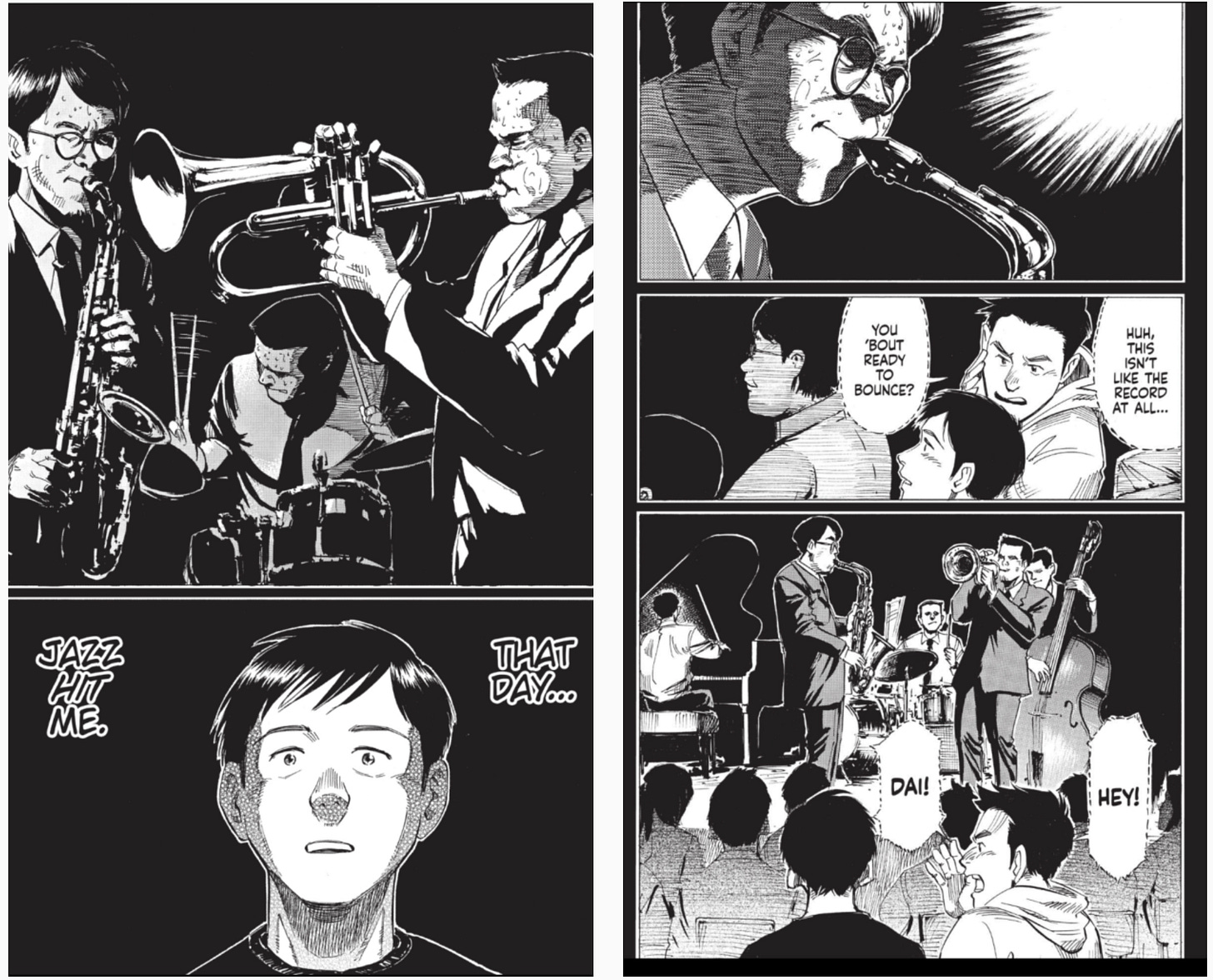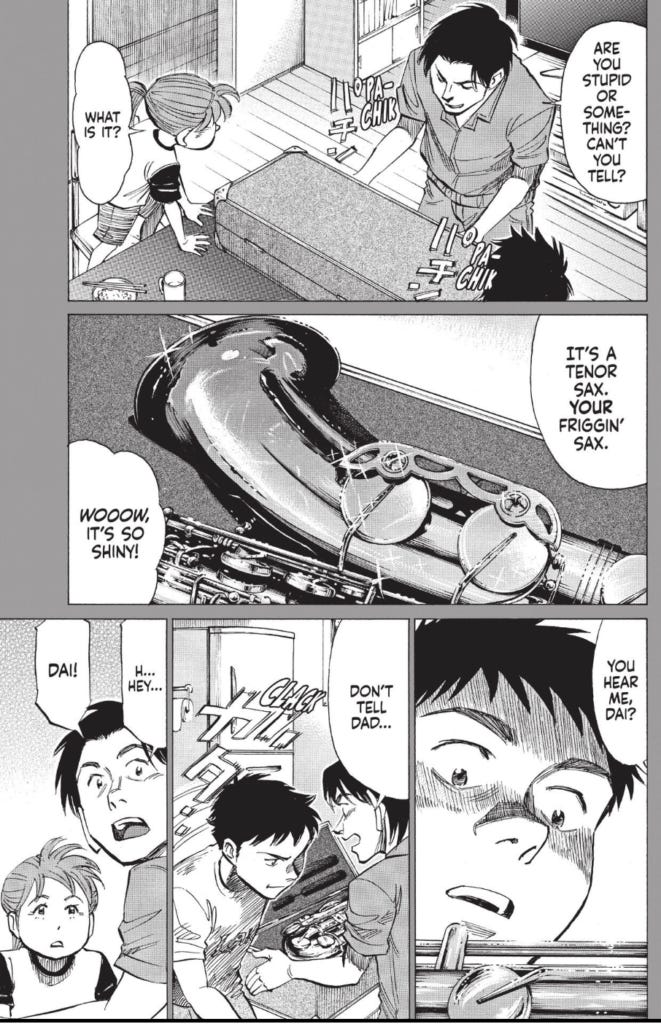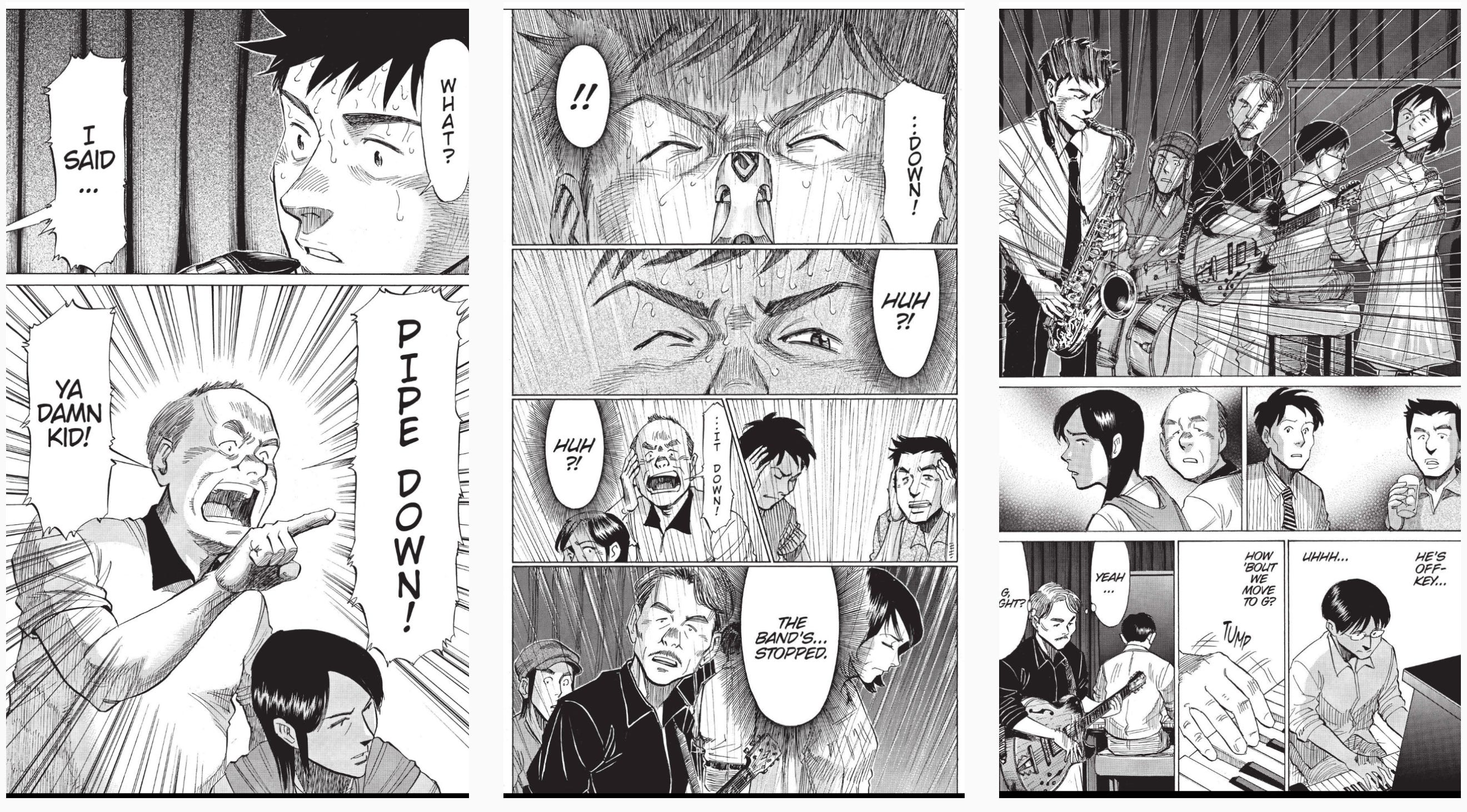BONUS - Ep. 64 Pre-Read: Blue Giant Vol. 1-4
We're taking a break this week, but now you can catch up on jazz manga Blue Giant vol. 1-4 before we talk about vol. 5-6!
[Deb:] So in our next episode of Mangasplaining, we're doing something a little different - we're NOT starting from volume 1! This time, we're diving straight into a story, Blue Giant by Shinichi Ishizuka by starting with volume 5 -- or in this case, volume 5-6, since Seven Seas Entertainment's edition of this award-winning manga about jazz is offered as 2-in-1 volume omnibus editions.
If you're new to Blue Giant and maybe you don't have time or the inclination to read volumes 1-4 before we post our next episode, here's what I'm-a gonna do for you: I'm sharing the pre-read summary of the main events of the first 1/3 of the series that I gave to Chip, Christopher and David. Needless to say, it is chock full of SPOILERS for those first 4 volumes. But read on, so you too can dive right into our discussion when our next podcast episode is posted next week.
Blue Giant volume 1-2 and volume 3-4
by Shinichi Ishizuka
Translated by Daniel Komen
Lettering and re-touch by Ludwig Sakamoto
Edited by J.P. Sullivan
Published by Seven Seas Entertainment (print / digital)
WHY ARE WE STARTING FROM BLUE GIANT VOL. 5-6?
Well, after recommending a few beloved manga series to Chip by giving him volume 1 to read, then discovering that maaaaybe for some manga (cough, Yotsuba&!, cough, cough Fullmetal Alchemist) that first volume doesn't always have all the things that made us fall in love with the story, I started wondering if maybe we should change things up a bit.
"It gets better once you read past volume X..." is something that people who recommend manga to people who haven't read much manga before end up saying a lot more than we'd care to admit. One reason why we haven't recommended One Piece yet is that it's generally agreed that it goes from good to great maybe 9-10 volumes into the series, and telling a new-to-manga reader to read 10 volumes before it "gets good" is maybe a lot to ask.
In the case of Blue Giant, starting with volume 5 maybe makes sense because this is when the second arc of the series kicks in, and the story really hits its stride. Volume 1-4 is mostly about Dai Miyamoto as a high school student, his initial introduction to the world of jazz, and playing the saxophone. At the end of volume 4 (a.k.a. omnibus volume 2), Dai graduates from high school, and moves to Tokyo to start his career as a professional musician. It's at this point that the story transforms from being like a shonen sports manga (where a young man gets into a sport, taps into his raw/innate talent thanks to his coaches and teammates, then aims for the top, usually a nationwide championship tournament) to being a more "grown-up" story, about a young man looking for his place in the world.
Japanese comics news site Comic Natalie recently posted an interview with saxophonist Sho Kaga, where he mentioned that his interest in Blue Giant really clicked after volume 5, when Dai meets pianist Yukinori Sawabe.
Up to Volume 4, (Blue Giant) is a story about a hot-blooded high school student / saxophonist (Miyamoto) doing his best. Of course it's interesting, but (this character) was so straightforward that I was left wondering, "What's up with this guy?" However, in Volume 5, we meet the pianist (Sawabe) Yukinori. Until then, Dai, who used to play the saxophone in his hometown of Sendai, was a frog in the well, but after graduating from high school, he goes to Tokyo where he meets Yukinori, who tells him, "I have more knowledge and experience -- Let's team up. However, if you suck, I'll get rid of you immediately. "
Yukinori practices insanely every day while holding a part-time job, so you can see the bottomlessness of great efforts. Immediately after that, I bought all 5 volumes (that were available then), and after that, whenever a new volume came out, I bought it and cried.-Sho Kaga (paraphrased/rough translation)
Anyway, I had already decided to start with volume 5-6 as our starting point for talking about Blue Giant on Mangasplaining when I saw this, but took it as a little pat on the back that this would be the right approach to introducing this manga to the crew. So without further ado, here's what you need to know about what happens in Blue Giant volumes 1-2 and volume 3-4.
BLUE GIANT VOL. 1-2
When Volume 1 opens, we meet Dai Miyamoto – he’s a high school senior who lives in Sendai (the city north of Tokyo where the Mangasplaining gang visited when we checked out the Shotaro Ishinomori Museums back in Fall 2019). For most of his high school years, he’s been playing basketball – but he realizes that he doesn’t have the height or innate talent to be great at the sport.
But when a friend takes him to a live jazz club when he’s in junior high, it ignites a passion that he’s never felt before.
So Dai gets a saxophone, and starts practicing / playing by himself by the riverside. He’s propelled by pure passion and curiosity - but for most of his first year of playing, he’s self-taught, and practices by himself – he can’t read sheet music and doesn’t know much about music theory either.
But one thing Dai has going for him (besides his never-say-die attitude and passion for jazz) is that his family is supportive of his dreams. While they’re not wealthy, his father (a widower who is a supermarket manager) and his 20-something older brother Masayuki (a foreman at a factory) encourage Dai to continue on his jazz journey, even if it means that he’ll skip college after he graduates high school. His brother even buys Dai an expensive, pro-class sax. His younger sister Ayaka doesn’t quite get what her ‘little big brother” is doing at first, but eventually, reluctantly accepts what he’s doing.
Another theme that comes up often in Blue Giant vol. 1-2 is that Dai (which means “big”) has a BIG sound - his playing, while untrained, is LOUD and full of emotion.

Sometimes Dai’s big sound impresses people, but at his first live gig with a band at a small jazz club, Dai finds out that sometimes, that his big sound isn’t always a good thing, especially when he’s playing for an audience, and when he plays with other musicians.
While this experience shakes Dai, he keeps pressing on, practicing alone as usual. Then the owner of the bar where he had his disastrous first performance seeks him out and asks him to return to the bar to play again – this time, before the bar opens and with a musician who “wants to hear him play.” This is when Dai meets his first music teacher, Mr. Yui, a cranky classically trained musician/composer/music teacher.
Mr. Yui then offers to give Dai lessons at his studio – and while he often tells Dai that he has shortcomings as a musician, he also tells the 17-year old that he has a lot of potential that even he might not understand fully yet.
BLUE GIANT VOL. 3-4
Blue Giant vol. 3 opens with some of Mr. Yui’s background story – his past dreams of becoming a world-class jazz musician when he went to the Berklee College of Music, and his current everyday life as a music teacher and composer of advertising jingles for TV commercials. Chapter 17 also offers some interesting contrasts between Yui’s lukewarm encouragement to his other (paying) students and the emotional investment he is putting into teaching Dai how to be a better musician.
In this scene from vol 3/Chapter 17, Yui reminisces with his Berklee school classmate Yutaka Katayama, a jazz pianist who’s in town for a club gig, but also concedes that he also has a day job at a department store to supplement his music career. As they talk over beers at an izakaya, we learn the meaning of the series title, Blue Giant.
So what's a "Blue Giant?" According to Merriam-Webster, it's "a bluish star that has a high surface temperature and a diameter that is large relative to the sun." Dai’s teacher uses this term to refer to a rare musician who is so transcendently talented, that he/she burns brighter, hotter than the rest.
Meanwhile, Dai is in his senior year of high school. His classmates don’t get jazz, and tease him about it, but that doesn’t discourage him, nor does it stop him from trying to get them as excited about jazz as he is.
His classmate Miwa (who he kind of dates, but their friendship seems mostly platonic) is supportive of his passion for music, but she doesn’t quite understand his strong feelings about jazz. As she studies for her college entrance exams, and Dai gets deeper into music, Miwa and Dai’s relationship fades to the background. (you’ll see her in the crowd below, reacting to his new haircut, and after Dai finishes his Coltrane solo at the school festival)
At the school festival, Dai goes on stage after a classmate’s rock band, to show his classmates what jazz is about and why he loves it so much. He even shows up with a Sonny Rollins-inspired mohawk cut and does a foot-stomping version of the school anthem accompanied by his high school music teacher on piano.
This scene is pretty much Dai’s “high school sports manga” moment – when he silences his critics, wins new fans and shows off the results of his hard work so far.
With that success under his belt, Dai later gets another chance to show the guy who yelled at him to get off the stage at his first live gig to give him another listen. He gets off to a rough start at first with the rest of the band, but when remembers to listen to the other musicians, he hits a groove that impresses even the cranky older man and the rest of the band too.
After the show, Dai asks his former heckler how he did, and gets some praise, albeit reluctantly. He also gets some rare praise from his hard-to-please teacher.
Dai graduates from high school and makes a fateful decision – he’s going to move to Tokyo to continue his journey toward becoming “the best sax player in the world.” He plays his sax for his father and siblings for the first time. After that, even Ayaka realizes that her “little big brother” can’t/shouldn’t stay in Sendai.
Chapter 30 in volume 4 finds Dai in Tokyo. He’s moved in with his old classmate Tamada, who is going to college. Dai meanwhile takes odd jobs at a restaurant and does construction work to pay the rent, while practicing his sax by a new riverside.
By chance, on a rainy day, he comes across a small jazz bar called Take Two. There’s no live jazz playing that night, but the owner plays an LP from her extensive collection, and Dai instantly feels like he’s found a new place to hang out.
Upon the bar owner’s recommendation, Dai heads to another nightspot to listen to an open mike night. It’s there that he sees a trumpet, bass and piano trio on stage. He’s instantly struck by the piano player, who is playing with his head back, his eyes closed and with only one hand on the keys.
“This guy… what is he?”
And that takes us to Blue Giant volume 5-6, which we’ll discuss on the next episode of our podcast.
OTHER FUN STUFF FROM BLUE GIANT VOL. 1-4
At the end of each volume of Blue Giant, there’s a part that feels like a documentary from not-too-distant future. Characters from prior chapters, looking perhaps 10-15 years older, talk with an unseen/unheard interviewer. The implication is that now Dai is a world-famous jazz musician, and these friends, family, teachers, classmates, acquaintances remember the events we saw in the manga through the lens of “I knew him before he got big.”

Also at the end of each volume are bonus comics featuring Shinichi Ishizuka and his editor (who wears a warrior hat that evokes Date Masamune, a hero from Sendai’s past).
Thanks for joining us on this very abbreviated, just the basics journey through Blue Giant volumes 1-4. There's a LOT more that happens in the manga, so I encourage you to pick it up, so you can read the rest.
We'll be back next week with the actual podcast episode, but while you wait, give my Blue Giant Spotify playlist a listen. I tried to grab songs and artists that are mentioned in Blue Giant volumes 1-10, so you can have a soundtrack playing while you read this manga about music!
Also, Okinawa returns this Friday, with a new chapter, so stay tuned for that too!
If you’re not already a Mangasplaining Extra subscriber, please consider joining us, either as a paid or free subscriber! We’re working hard behind the scenes to bring you even more original manga and articles, so stay tuned!



























On the one hand, this looks amazing. I really want to read it.
On the other hand, I'm incredibly disappointed that the publisher, Seven Seas, is trying to bust the attempts at unionization by its workers. See here:
https://kotaku.com/seven-seas-entertainment-manga-union-united-workers-in-1848996599
https://bleedingcool.com/comics/seven-seas-hires-lawyers-to-deal-with-new-manga-union/
I've read the newsletters for MSX, but am way behind on the podcasts, so if you've addressed this on the show, I apologize, but this might be worth discussing when you next record.
Thank you for the explainer! I'm motivated to listen to you all talk about it now.
Totally agree on the One Piece comment. I always suggested starting with Nami's arc and if the moment at Arlong Park didn't move the reader, to just...read something else. ^_^